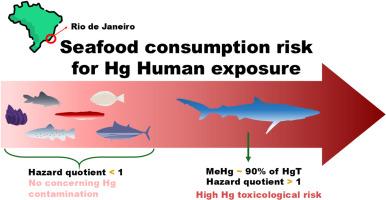The tastiest is not always the safest: mercury risks of boneless fish consumption compared to other seafood traded in southeastern Brazil
IF 3.5
3区 医学
Q2 FOOD SCIENCE & TECHNOLOGY
引用次数: 0
Abstract
Seafood plays a crucial role in the food supply, but it is also a source of contaminants, such as mercury. The ubiquity, high toxicity, and biomagnification of mercury justify its monitoring in seafood as a priority for achieving the 2030 food safety goals. This study aimed to determine the total mercury (THg) and methylmercury (MeHg) contamination in eight seafood species commercially available in a metropolitan region of southeastern Brazil, thereby generating the Estimated Daily Intake (EDI) and the Hazard Quotient (HQ). The lowest THg concentrations were found in pangas and mussels (0.0003 ± 0.0003 and 0.0005 ± 0.0002 mg.kg−1 w.w., respectively), while the highest were found in blue sharks (1.27 ± 0.46 mg kg−1, w.w.). The blue shark was the only species with THg concentrations above the limit of 0.5 mg kg−1 for fish set by the WHO and the most toxic form of mercury, MeHg, predominated in 80 % of them. The blue shark HQ ranged from 0.91 to 2.97 and from 2.06 to 6.71 for Hg and MeHg. Therefore, the consumption of this specific group of seafood should be restricted or preferably avoided. Further studies should enhance the information on fish consumption among vulnerable and more exposed populations to obtain more reliable health risk assessments.

最美味的并不总是最安全的:与巴西东南部交易的其他海鲜相比,食用无骨鱼有汞风险。
海鲜在食物供应中起着至关重要的作用,但它也是汞等污染物的来源。汞的普遍存在、高毒性和生物放大性证明,对海产品中的汞进行监测是实现2030年食品安全目标的优先事项。本研究旨在确定巴西东南部大都市地区8种市售海产品中的总汞(THg)和甲基汞(MeHg)污染,从而得出估计每日摄入量(EDI)和危害商数(HQ)。甲鱼和贻贝的THg浓度最低(分别为0.0003±0.0003和0.0005±0.0002 mg.kg-1 w.w),大蓝鲨的THg浓度最高(1.27±0.46 mg.kg-1, w.w)。蓝鲨是唯一THg浓度超过世界卫生组织(WHO)规定的0.5 mg.kg-1上限的鱼类,其中80%的鲨鱼体内主要含有毒性最强的汞——甲基汞(MeHg)。对Hg和MeHg,蓝鲨的HQ值在0.91 ~ 2.97之间,在2.06 ~ 6.71之间。因此,应限制或尽量避免食用这类海鲜。进一步的研究应加强关于脆弱和更多受影响人群的鱼类消费的信息,以获得更可靠的健康风险评估。
本文章由计算机程序翻译,如有差异,请以英文原文为准。
求助全文
约1分钟内获得全文
求助全文
来源期刊

Food and Chemical Toxicology
工程技术-毒理学
CiteScore
10.90
自引率
4.70%
发文量
651
审稿时长
31 days
期刊介绍:
Food and Chemical Toxicology (FCT), an internationally renowned journal, that publishes original research articles and reviews on toxic effects, in animals and humans, of natural or synthetic chemicals occurring in the human environment with particular emphasis on food, drugs, and chemicals, including agricultural and industrial safety, and consumer product safety. Areas such as safety evaluation of novel foods and ingredients, biotechnologically-derived products, and nanomaterials are included in the scope of the journal. FCT also encourages submission of papers on inter-relationships between nutrition and toxicology and on in vitro techniques, particularly those fostering the 3 Rs.
The principal aim of the journal is to publish high impact, scholarly work and to serve as a multidisciplinary forum for research in toxicology. Papers submitted will be judged on the basis of scientific originality and contribution to the field, quality and subject matter. Studies should address at least one of the following:
-Adverse physiological/biochemical, or pathological changes induced by specific defined substances
-New techniques for assessing potential toxicity, including molecular biology
-Mechanisms underlying toxic phenomena
-Toxicological examinations of specific chemicals or consumer products, both those showing adverse effects and those demonstrating safety, that meet current standards of scientific acceptability.
Authors must clearly and briefly identify what novel toxic effect (s) or toxic mechanism (s) of the chemical are being reported and what their significance is in the abstract. Furthermore, sufficient doses should be included in order to provide information on NOAEL/LOAEL values.
 求助内容:
求助内容: 应助结果提醒方式:
应助结果提醒方式:


